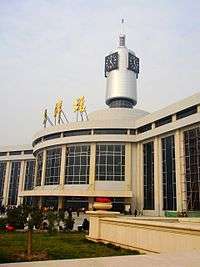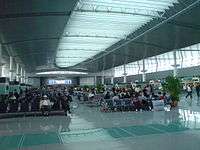Tianjin Railway Station
 Tianjin Station, south entrance | |
| Location |
East Haihe Road, Hedong, Hebei District, Tianjin China |
| Coordinates | Coordinates: 39°8′5″N 117°12′11″E / 39.13472°N 117.20306°E |
| Platforms | 10 |
| Connections |
|
| History | |
| Opened | 1888, rebuilt in 1987-1988, and restructured in 2007-2008 |
The Tianjin Railway Station (Chinese: 天津站; pinyin: Tiānjīn Zhàn) is the principal railway station in Tianjin, China. It was built in 1888, was rebuilt in 1987-1988, and restructured in 2007-2008. Its Chinese big title was written by Deng Xiaoping in 1988, for celebrating 100th anniversary of its founding.[1]
Since 1 August 2008, it serves as the terminus for high-speed trains to the city, including the Beijing–Tianjin Intercity Railway, which can reach speeds above 350km/h.
Historical development
Qing Dynasty period

In 1888, the Kaiping Tramway and Imperial Railways of North China was extended to Tianjin and was subsequently renamed as the Jintang Railway (津唐铁路). The Tianjin Railway became the first Train station completed in China at the time. Construction of the railroad had begun in 1886 and was situated near the Hai River.[2] On 10 May 1888. In May 1891, a larger station was built 500 metres to the west and a civil structure contained a three-storey building.

The "Old Dragon Head" Railway Station was destroyed during the Boxer Rebellion Incident. In June 1900, the Eight-Nation Alliance besieged Tianjin and battled the Boxers in the black bamboo forest outside the British and French Concession. During the ten days of fighting, the Station buildings were also destroyed. By July 1900, the armies of the Eight-Nation Alliance occupied Tianjin and the east coast of the rail station became the occupied zone of the Russian army. By December that same year, the Russian Concession was opened and the rail station was now located within the boundaries of the concession. This was strongly opposed by the British and in the end, through the intermediation of Germany, the Russians eventually gave in.[3]
Republic of China period
_railway_station_1948.jpg)
After the Jinghu railway and Tianjin West Station was constructed in 1911, the "Old Tianjin Station" renamed the Tianjin East Station, hence the Tianjin Railway was categorised into North, East and West Stations. The Tianjin East Station later became the Jingha railway and intersected the Jinpu railway line. On 10 October 1930, The Tianjin East Station was listed among the international train stations at the time.[4] During the period from 1916 to 1946 the Tianjin East Station was approved by the Republic of China Ministry of Railways as a first-class station, and since 1947 the principal station was upgraded.
People's Republic of China period
After the establishment of the People's Republic of China throughout the country in 1949, the Tianjin East Station was renamed the Tianjin Station and since then, and successive inspections by the Ministry of Railways have classified it as a top grade station. In 1950, the Tianjin Station waiting rooms were expanded by more than one thousand square metres, and for more than thirty years since then there had been no further large-scale expansion works undertaken.
After the Chinese economic reform, the burden of transportation on the Tianjin Station has been increasing due to the sharp increase in passenger traffic, and the average daily number of passengers was sixty five thousand. After receiving from the State Council and the Ministry of Railways, the Tianjin Municipal Government decided to expand the "Tianjin Railway Improvement Project" and this item was also included among the key projects in the national "Seventh Five-Year Plan".[5] From 15 April 1987, thorough renovation work was conducted on the Tianjin Railway Station. New roofing was constructed on the original site of the old station house and also on the sixty-six metre high cylindrical Clock Tower, face Hai River.[6] The construction work was completed on 25 September 1988. On the eve 1 October of that same year, which was the centenary of the establishment of the Tianjin Station, the then Minister of Railways Li Senmao (李茂森) cut the ribbon and officially opened the new station building of the Tianjin Station.[7] The newly renovations had increased the Tianijn Station's daily receiving passenger capacity from forty-six pairs to ninety-five pairs and was one of the most advanced modern railway stations in China at the time.

As a co-host city of the 2008 Beijing Olympics, in order to coordinate the hosting of the Games along with the construction of the Beijing–Tianjin Intercity Railway and the Tianjin Underground Zhijing Line (天津地下直径线) as well as the introduction of the Jin-Qin Passenger Dedicated Line (津秦客运专线), Tianjin City launched the overall construction of the "Tianjin Station Traffic Junction". Starting from 15 January, the Tianjin Railway Station closed for the first time since the last reconstruction in 1988. To ensure the project reconstruction could proceed smoothly, the Railway Station's passenger operations were temporarily halted and the bus station of Tianjin (known as the Tianjin Passenger Technology Station) was converted into the "Temporary Passenger Station in Tianjin Station" and was formally put into use as a temporary substitute for traffic.[8] At the same time, the majority of the Tianjin Railway Station bus terminals were moved to the Yueya River train station (月牙河火车站).
Networks
Since 1 October 2012, the station is connected to the Tianjin Metro network, the new Lines 2 and 3 as well as Binhai Mass Transit (Line 9) intersect at the station.
| Preceding station | Following station | |||
|---|---|---|---|---|
towards Beijing South | Beijing–Tianjin Intercity Railway | Terminus | ||
Terminus | Tianjin–Qinhuangdao High-Speed Railway | towards Qinhuangdao |
||
| Preceding station | Following station | |||
towards Beijing | Beijing–Harbin Railway | towards Harbin |
||
| Beijing–Shanghai Railway | towards Shanghai |
|||
| Terminus | Tianjin–Pukou Railway | towards Pukou |
Station house structure


At present, the Tianjin Railway Station, includes the Beijing–Tianjin Intercity Railway and the North station railway. The elevated waiting room, underground pit room, high platform canopy, passenger tunnel, line package channels have a total construction area of one hundred and eighty five thousand square metres of which the newly built North station house comprises seventy-one thousand square metres, the South Station house has thirty-three thousand square metres and the canopy has eighty-one thousand square metres. The elevated waiting room is twenty-two thousand square metres and can accommodate six thousand passengers[9]。The Office is located in the basement of the underground pitand and has a construction area of twelve thousand four hundred square meters.
Dome Mural
In the spring of 1988,Li Ruihuan, then he was Tianjin mayor, inspired by the Sistine Chapel ceiling during his visit to Italy, ordered to paint a similar dome mural for the entrance hall of the station.It took four months to complete the mural before October 1, the National Day of 1988, by old painter Qin Zheng(秦征) and his students.The subject of the mural is "Jingwei Tries to Fill the Sea", a Chinese mythology in Baroque style.Jingwei was depicted as a naked woman with two wings and long hair, which broke the taboo of nude for the first time after the Culture Revolution.It was once the biggest Dome Mural in China.In order to protect the oil painting, Tianjin Railway station became the China's first public place forbidding smoking.[10][11]
Transport Plaza
The Tianjin Metro's Line Two, Line Three, Line Nine are located in the underground station of Tianjin Station and since October 2012 form a rail transfer center hub.[12] The Ground loop distribution for the square will cover an area of twenty four square meters.
Station scenery
- The Jin Tower situated across the Hai River.
- The Tianjin Century Clock in front of the Tianjin Railway Station Square.
- The Tianjin World Financial Center situated across the Hai River.
Layout of the ticket window

Inside the Train Station, there are sixty-two manual ticket windows including twenty-three Ticket vending machines of the Beijing–Tianjin Intercity Railway and sixty-five sets of automatic entry and exit gates.[13]
| Tianjin South station house ticket office[14] | Tianjin North station house ticket office | Beijing-Tianjin inter-city self-service ticket vending machines |
|---|---|---|
|
|
|
See also
Notes and references
- ↑ "1988年3月22日:邓小平为天津站建站一百周年的题名". 中国共产党新闻网. 27 November 2014. Retrieved 31 January 2016.
- ↑ Map of Tianjin's Growth: The century-old station turned into a gorgeous train station (天津成長地圖:百年『老龍頭』火車站華麗變身)
- ↑ 孙瑞芹:《德国外交文件有关中国交涉史料选译》第2卷,商务印书馆1960年版,第288页
- ↑ The History of Urban Transportation Changes: Tianjin's century-old railway station
- ↑ Tianjin Station Reconstruction integrates Beijing and Tianjin closer by half an hour(天津站改建綜合樞紐 半小時拉近京津)
- ↑ The Participation Officers inspecting the Passenger Station during that year tells the old story of the Tianjin Station (当年参建人员参观新客站 讲述老天津站故事)
- ↑ Illustrations of Historical Changes to the century-old Tianjin Railway Station (天津站百年老站旧貌换新颜 图说历史变迁)
- ↑ The Tianjin Station as one the largest temporary passenger station renovation projects put into operation (天津站规模最大改造工程启动 临时客站投入运营)
- ↑ Tianjin Railway Station Introductory (天津站介绍)
- ↑ 王文治 (14 August 2011). "《精卫填海》与天津站禁烟". 今晚报. Retrieved 31 January 2016.
- ↑ 孙福海 (31 March 2010). "嘛叫天津人的真格的——话说著名油画家秦征". 天津文艺界. Retrieved 31 January 2016.
- ↑ The quest for a rail transfer center in Tianjin Station's underground subway intersection (天津站轨道换乘中心探秘 地下4层交会3条地铁)
- ↑ Tianjin Tourism Bureau: An Introduction to visiting the Tianjin High Speed Rail Station (天津市旅游局:乘高铁·逛津城之天津站介绍)
- ↑ Tianjin Railway Station Passenger Service Guide (天津站旅客服务指南)
External links
| Wikimedia Commons has media related to Tianjin Railway Station. |